12th Century Babulnath Temple Mumbai
Babulnath Temple is an ancient Hindu temple dedicated to Lord Shiva, located in Mumbai, Maharashtra, India. Perched atop a hillock near Girgaum Chowpatty, it’s one of the oldest temples in the city, offering mesmerizing views of the Arabian Sea.
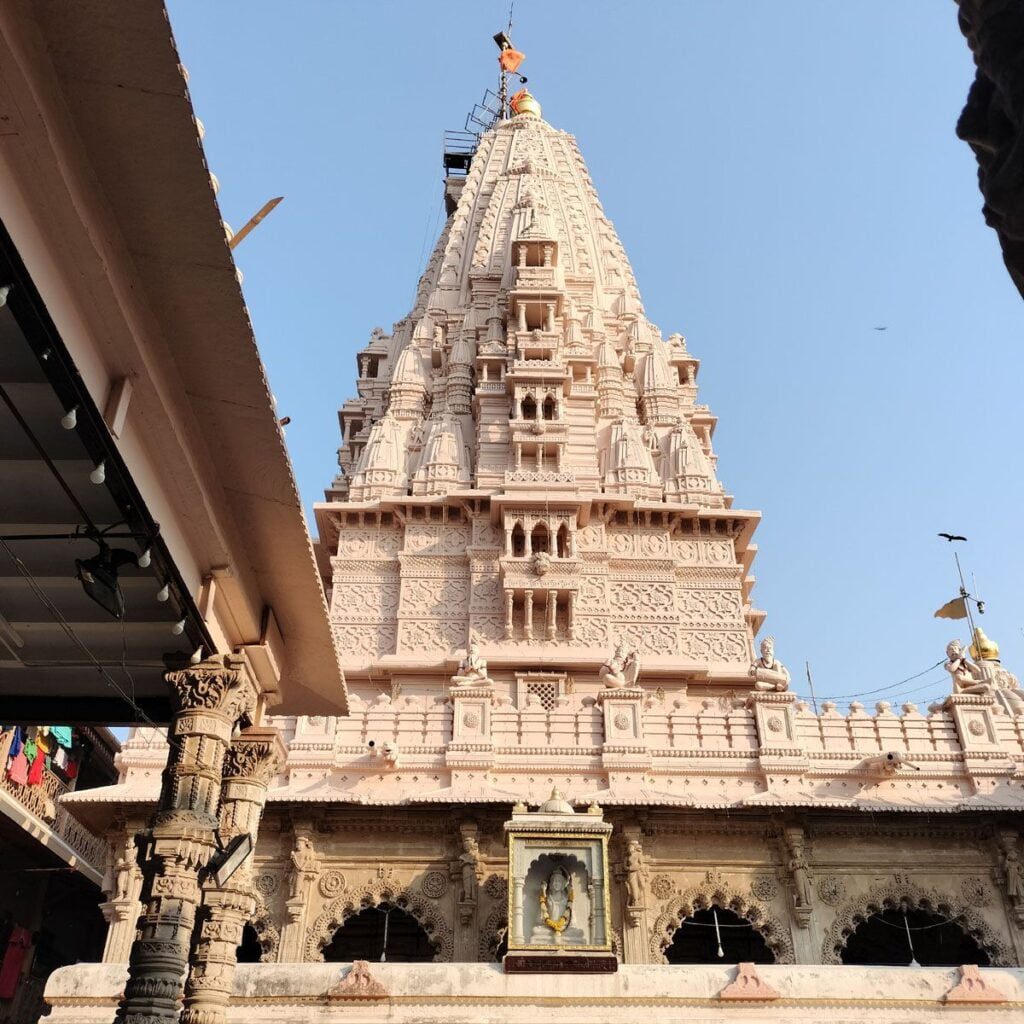
Contents
Babulnath Temple History:
Early Origins (12th Century)
- According to tradition, the temple’s earliest incarnation dates back to the 12th century, established by the then Hindu king Bhimdev.
- This initial temple enshrined a “swayambhu” or self-manifest Shiva linga, representing the inherent divinity of the place.
Rediscovery and Reconstruction (18th Century)
- Over time, the original temple fell into disrepair and vanished from sight, eventually getting buried.
- In the late 18th century, around 1780, the site was rediscovered due to a curious legend involving a cow pouring its milk at a specific spot. Excavation revealed the ancient Shiva linga and other idols.
- A new temple was then constructed on the rediscovered site, marking the revival of Babulnath as a major center of worship.
Later Developments and Modern Day
- The current structure of the temple dates back to 1890, built with significant contributions from the Maharaja Sayajirao Gaikwad of Baroda.
- Unfortunately, a lightning strike in the 1960s damaged the spire, reducing the temple’s original height.
- Despite this, Babulnath remains a highly revered pilgrimage center, especially during Mahashivaratri, attracting devout followers of Lord Shiva from across India and beyond.
- An elevator was installed alongside the traditional stairs in recent years, offering easier access for pilgrims.
Read More>> Titwala Ganesh Mandir: Where Devotion Meets Serenity
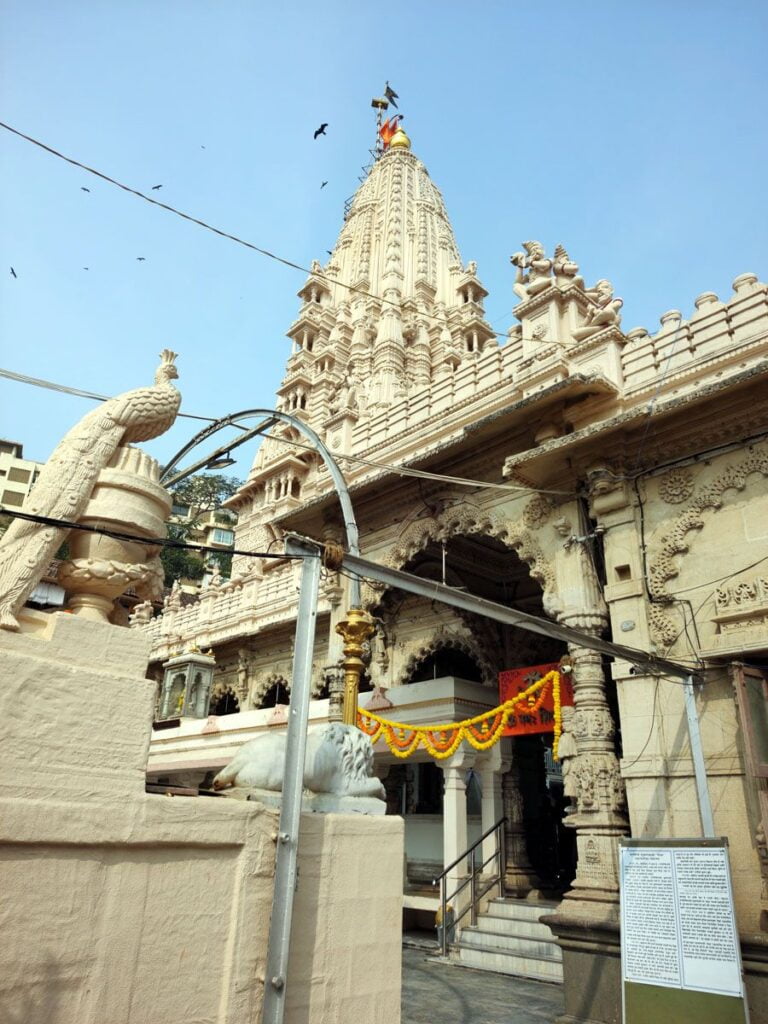
Legend of Babulnath Temple:
The story goes back around two centuries, when the land where the temple now stands belonged to a wealthy goldsmith named Pandurang. He entrusted the care of his cattle to a dedicated herdsman named Babul. One day, Pandurang noticed a curious anomaly – his prized cow, Kapila, stopped giving milk at the end of her grazing rounds.
Intrigued, Pandurang followed Kapila, and what he witnessed left him awestruck. At a specific spot, seemingly drawn by an invisible force, Kapila would stand on her hind legs and spontaneously pour out all her milk as an offering. The ground at that spot remained curiously moist, even during the driest summers.
Driven by a sense of divine calling, Pandurang ordered the ground to be dug. And voila! What they unearthed was a breathtaking sight – a self-manifested Shivling, carved from black stone and radiating an otherworldly aura. This miraculous discovery revealed the presence of Lord Shiva himself, worshipped for millennia under the shade of a sacred Babul tree.
News of the divine Shivling spread like wildfire, and soon, devotees flocked to the site. A makeshift temple was built around the sacred object, and the hill came to be known as Babulnath, after the faithful herdsman who first witnessed the miracle. Over time, the temple was expanded and adorned, becoming the magnificent edifice we see today.
This legend speaks not only of divine intervention but also of the transformative power of faith. It reminds us that the divine can reveal itself in the most unexpected ways, even amidst the bustling city life of Mumbai. The Babulnath Temple, with its serene ambiance and rich history, stands as a testament to this timeless truth, attracting devotees and curious wanderers alike.
Read More>> Trimbakeshwar Jyotirlinga Temple
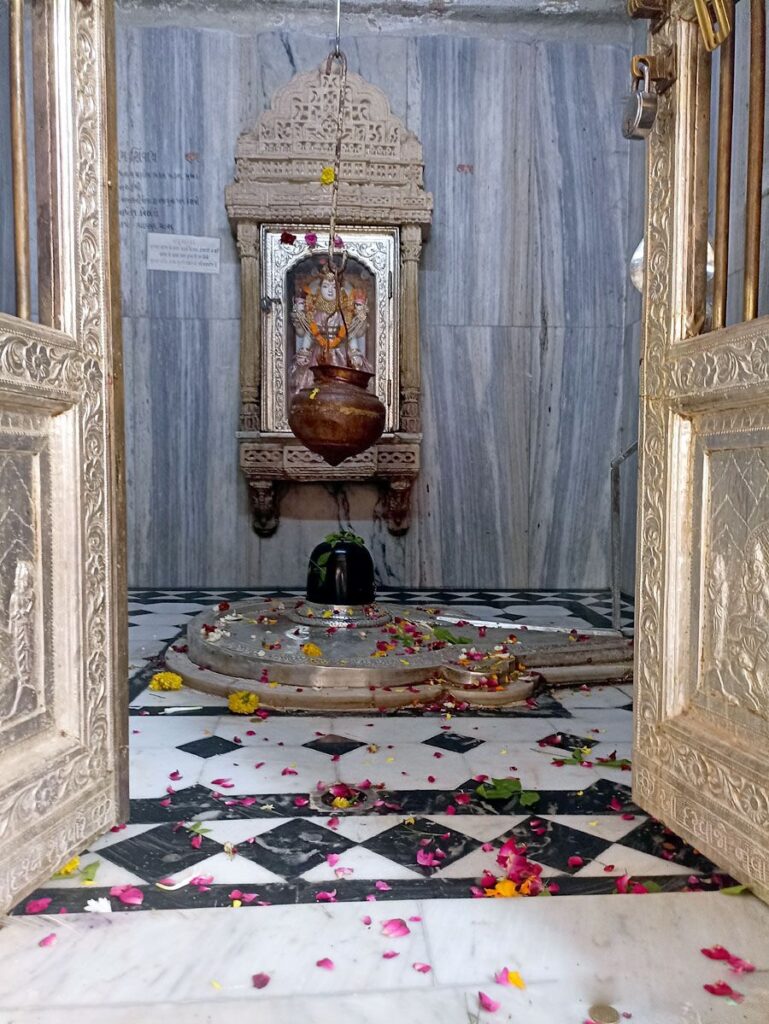
Myths and Beliefs of Babulnath Temple:
1. The Miracle of the Self-Manifested Shivling:
The central myth revolves around the discovery of the Shivling itself. Legend has it that centuries ago, a pious cowherd named Babul, tending to the cattle of a wealthy goldsmith, noticed a curious phenomenon. A particular cow, Kapila, would stop at a specific spot each day and offer her milk to the ground, leaving it mysteriously moist even during droughts. Intrigued, the goldsmith followed the cow and unearthed a black stone Shivling, believed to have manifested on its own. This miraculous event marked the presence of Lord Shiva, and the hill came to be known as Babulnath, in honor of the devoted cowherd.
2. Blessings of Lord Babulnath:
Devotees believe that Lord Babulnath, enshrined within the temple, showers blessings upon those who seek them with sincerity. Wishes whispered near the sacred Shivling are said to find their way to the heavens, and prayers offered with unwavering faith are believed to be answered. Stories abound of devotees who have experienced miracles, regained health, and achieved success after seeking Lord Babulnath’s blessings.
3. The Wish-Fulfilling Peepal Tree:
Within the temple complex stands a majestic peepal tree, adorned with colorful threads and ribbons. Devotees tie these threads, each knot carrying a wish or prayer, to the branches, seeking the tree’s mystical intervention. It is believed that the rustling leaves of the peepal carry these wishes to the heavens, ensuring their fulfillment.
4. The Power of Nandi:
The imposing statue of Nandi, Lord Shiva’s bull, guarding the entrance to the temple, is another focal point of belief. Devotees touch Nandi’s horns and whisper their prayers, seeking his blessings for strength, protection, and perseverance. Nandi is believed to be a conduit to Lord Shiva, carrying the wishes of his devotees directly to the divine.
5. The Sacred Hill and the Seven Steps:
The climb up the seven steps to the temple is considered a symbolic journey of spiritual ascension. Each step is believed to shed a layer of worldly attachments, preparing the devotee for a divine encounter with Lord Babulnath. Reaching the top and offering prayers at the sanctum sanctorum is seen as a culmination of this spiritual journey.
Read More>> Shirdi Sai Baba Temple Maharashtra
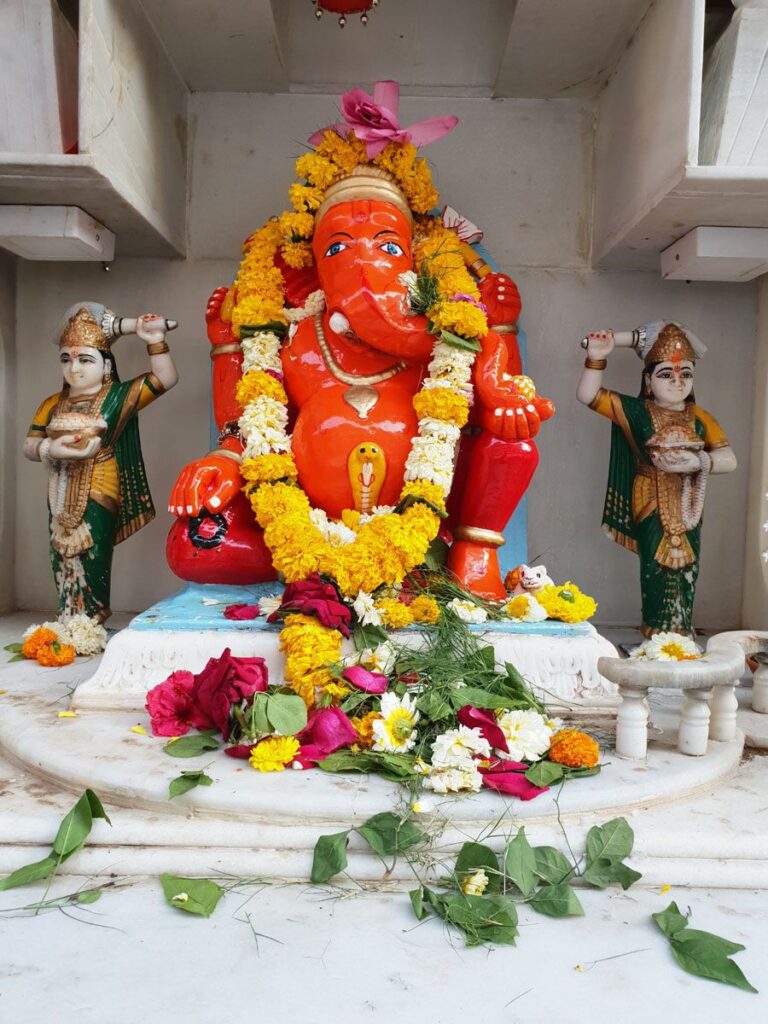
Significance of Babulnath Temple:
Religious Significance:
- Dedicated to Lord Shiva: The temple is primarily dedicated to Lord Shiva, one of the principal deities in Hinduism. Worshipped in the form of the “Lord of the Babul tree,” Shiva’s presence imbues the temple with powerful spiritual energy.
- Swayambhu Shivling: The central object of worship is a self-manifested Shivling, believed to have emerged from the earth centuries ago. This adds to the temple’s sanctity and attracts devotees seeking blessings and spiritual connection.
Historical Significance:
- Ancient roots: Though the current structure dates back to the 19th century, the temple’s origins trace back to the 12th century. Legends narrate stories of a cow offering milk and the discovery of the Shivling, hinting at its long-standing presence.
- Architectural marvel: The temple showcases intricate carvings, sculptures, and artwork, reflecting various architectural styles. The blend of Indian and European influences reflects the city’s rich history and cultural exchange.
- Witness to Mumbai’s transformation: Situated on a hillock overlooking the Arabian Sea, the temple has been a silent observer of Mumbai’s evolution from a fishing village to a bustling metropolis.
Cultural Significance:
- Interfaith harmony: The temple attracts devotees from diverse backgrounds, religions, and communities, fostering a sense of unity and inclusivity.
- Festivals and rituals: Vibrant festivals like Mahashivaratri and Ganesh Chaturthi transform the temple into a hub of joyous celebrations, showcasing traditional customs and rituals.
- Local community anchor: The temple serves as a focal point for the local community, hosting social gatherings, charitable activities, and educational programs.
Read More>> Mahabaleshwar Temple Maharashtra: 1200 yrs Sacred Atmalinga
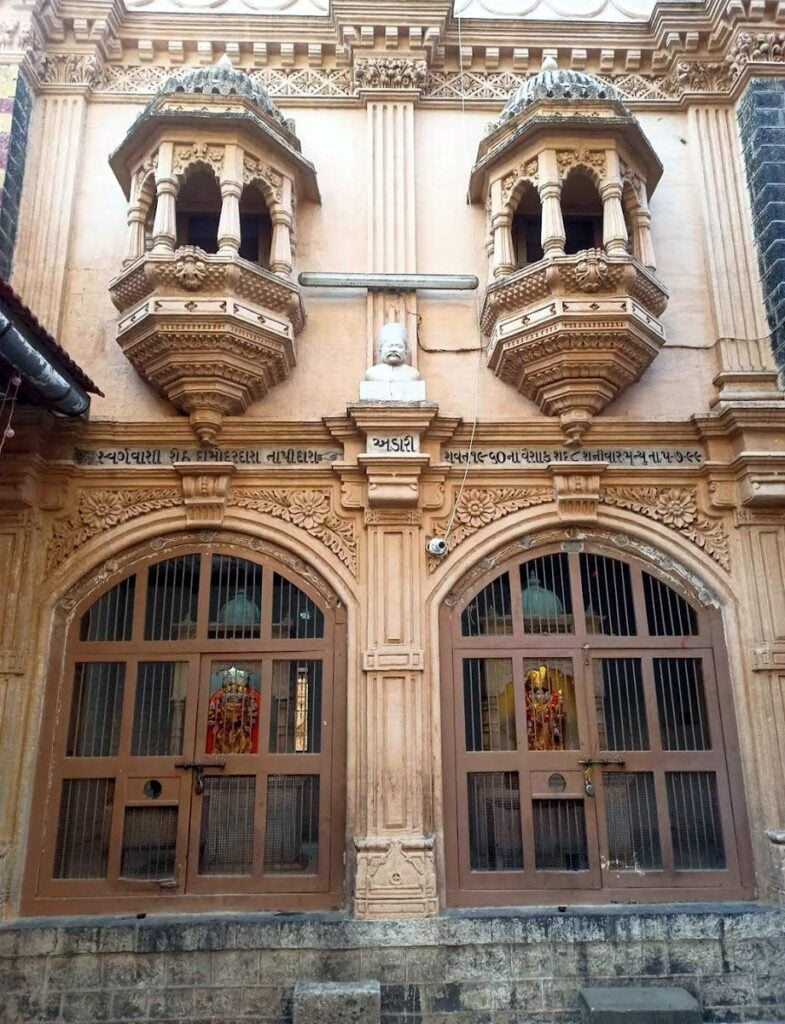
Babulnath Temple Timing and Rituals:
Timings:
- Darshan: 5:00 AM to 8:59 PM
- Morning Pooja: 5:45 AM to 7:00 AM
- Mid-noon Pooja: 11:00 AM to 12:00 PM
- Evening Pooja: 4:45 PM to 6:00 PM
- Aarti:
- Morning: 6:30 AM to 7:15 AM
- Mid-noon: 11:30 AM to 12:15 PM
- Evening: 5:15 PM to 6:00 PM
- Night: 8:00 PM
Rituals:
- Trikal Darshan: The temple observes three daily pujas, symbolizing the Trikal (three times) – morning, noon, and evening. Each puja involves offerings, chanting of hymns, and prayers.
- Abhishek: This special ritual involves bathing the Shivling with milk, water, and other sacred offerings. It is performed in the mornings (except Mondays) from 6:00 AM to 11:30 AM.
- Aarti: The traditional lamp-waving ceremony takes place four times a day, creating a mesmerizing and devotional atmosphere.
- Other Offerings: Devotees can offer fruits, flowers, bel leaves, and other sacred items to Lord Shiva.
Special Occasions:
- Mahashivaratri: This grand festival dedicated to Lord Shiva is celebrated with great fervor at the Babulnath Temple. Special pujas, processions, and all-night chanting fill the temple with an electrifying energy.
- Shravan Maas: During this holy month dedicated to Lord Shiva, special ghee poojas are performed at the temple.
Read More>> Saptashrungi Bhadrakali Temple Nasik
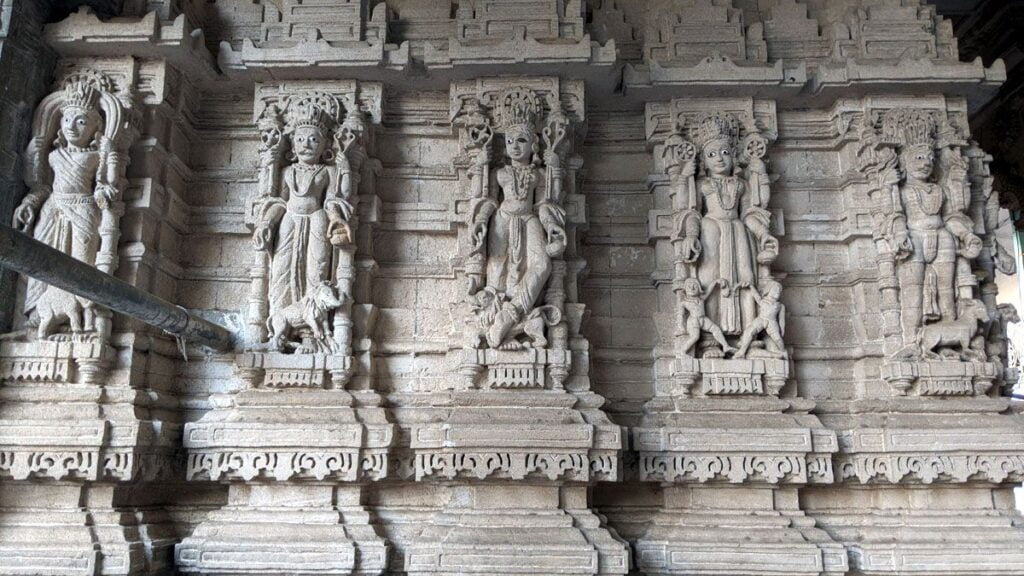
Places to visit near Babulnath Temple:
- Marine Drive: Enjoy a leisurely stroll along the iconic Marine Drive, also known as the Queen’s Necklace, offering stunning views of the Arabian Sea.
- Chowpatty Beach: Experience the vibrant atmosphere at Chowpatty Beach, known for its street food, cultural events, and relaxing beachfront.
- Gateway of India: Visit the historic Gateway of India, an architectural marvel overlooking the Arabian Sea, and explore the bustling Colaba area.
- Hanging Gardens: Find tranquility in the Hanging Gardens, a beautiful terraced garden perched on the slopes of Malabar Hill, offering panoramic views of the city.
- Kamala Nehru Park: Adjacent to the Hanging Gardens, Kamala Nehru Park is a peaceful green space with charming pathways and a giant shoe-shaped structure for kids to play.
- Mahalakshmi Temple: Pay your respects at the Mahalakshmi Temple, dedicated to the goddess Mahalakshmi, just a short distance from Babulnath Temple.
- Mani Bhavan: Delve into the history of Mahatma Gandhi at Mani Bhavan, a museum and memorial dedicated to his life and work.
- Jehangir Art Gallery: Explore the vibrant art scene at Jehangir Art Gallery, showcasing a diverse range of contemporary and traditional Indian art.
- Haji Ali Dargah: Visit the iconic Haji Ali Dargah, a mosque and tomb located on an islet off the coast of Worli, accessible through a causeway.
- Kamla Nehru Park: Enjoy a serene retreat at Kamla Nehru Park, featuring lush greenery, well-maintained lawns, and captivating views of the cityscape.
FAQ:
Q: What is the Babulnath Temple?
The Babulnath Temple is an ancient Hindu temple dedicated to Lord Shiva, one of the principal deities in Hinduism. It is located on a small hillock in Malabar Hill, Mumbai, India, offering breathtaking views of the Arabian Sea. The temple is considered one of the oldest in Mumbai, with its origins dating back to the 12th century.
Q: Who is the main deity worshipped at the Babulnath Temple?
The main deity worshipped at the Babulnath Temple is Lord Shiva, specifically in the form of the “Lord of the Babul tree.” The temple’s name comes from the “Babul” tree, which used to grow abundantly on the hillock.
Q: What is the significance of the Babulnath Temple?
The Babulnath Temple is a significant pilgrimage site for Hindus, especially on Mondays and during festivals like Mahashivratri. Devotees believe that praying at the temple brings blessings, prosperity, and good health. The temple is also known for its peaceful and serene atmosphere, offering a welcome escape from the bustling city life of Mumbai.
Q: How can I reach the Babulnath Temple?
The Babulnath Temple is accessible by road and on foot. You can take a taxi or rickshaw to the temple or walk from Chowpatty Beach. There is also an elevator available for those who cannot climb the 108 steps to the temple.
Q: What are the timings of the Babulnath Temple?
The Babulnath Temple is open from 6:00 AM to 9:00 PM every day. The temple performs four aartis (prayer ceremonies) throughout the day:
- Pratah Abhishek Pooja Aarti: 6:30 AM to 7:15 AM
- Madhyan Abhishek Pooja Aarti: 11:30 AM to 12:15 PM
- Sandhya Abhishek Pooja Aarti: 5:15 PM to 6:00 PM
- Sayan Aarti: 8:00 PM to 8:15 PM
Q: Are there any special events or festivals at the Babulnath Temple?
The Babulnath Temple celebrates several special events and festivals throughout the year, including:
- Mahashivratri: The night of Lord Shiva’s wedding to Parvati is one of the most important festivals celebrated at the temple. Lakhs of devotees visit the temple on this day to offer prayers and seek blessings.
- Mondays: Mondays are dedicated to Lord Shiva, and the temple sees a large number of devotees on this day.
- Pradosh: The evenings of Pradosh, the 12th and 27th days of the lunar month, are also considered auspicious for worshipping Lord Shiva.
Q: What are some interesting facts about the Babulnath Temple?
- The Babulnath Temple is one of the highest points in Mumbai, offering panoramic views of the city and the Arabian Sea.
- The temple is believed to have been built by a Hindu merchant in the 12th century.
- The current structure of the temple was built in 1890 by the Maharaja Sayajirao Gaikwad of Baroda.
- The temple was struck by lightning in the 1960s, damaging its spire and reducing its height significantly.
How to reach Babulnath Temple:
By Air:
- Chhatrapati Shivaji Maharaj International Airport (BOM): The nearest international airport is about 20 kilometers away from the temple. From the airport, you can hire a taxi or use app-based cab services to reach Babulnath Temple.
By Train:
- Local Trains: The nearest railway station is Charni Road Railway Station, which is about 3 kilometers away from the temple. From there, you can hire a taxi, take a bus, or use local transportation to reach the temple.
By Road:
- Taxis and Cabs: Taxis and app-based cab services are readily available in Mumbai. You can hire one to take you directly to Babulnath Temple.
- Buses: Public buses and private buses operate within Mumbai. Various bus routes pass through the area near Babulnath Temple.

One Comment